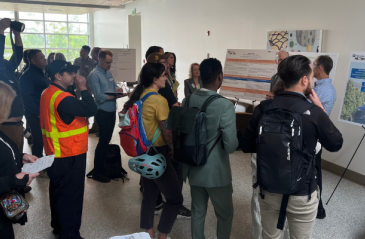
The information barriers holding back climate action and how to break them

Tom Burbage sought to recreate the unity of a fighter squadron in private sector teams
Share articleTrue leadership is about inspiring people to perform above their expected performance
Share articleKeeping many governments informed about the F-35 programme required clear, regular communication
Share articleWe put our vision for government into practice through learning partner projects that align with our values and help reimagine government so that it works for everyone.
"No, I served in the Navy, not the Air Force," says Charles “Tom” Burbage, politely but firmly. It's a correction which speaks volumes.
Firstly, it's an easy mistake for an outsider to make - think “military pilot” and the natural instinct is Air Force - but it also reflects Burbage's enduring loyalty to the Navy, as well as his deep gratitude for 25 years in uniform. The experiences he gained serving on aircraft carriers, at the Naval Test Pilot School, and as an engineering test pilot and squadron leader shaped his insights and approach to his subsequent stellar career in the private sector - a period which brought him into close contact with senior corporate and government leaders alike.
But more of that later.
Anyone who has seen Top Gun - which, let's face it, is most of us - knows that every fighter pilot has a call sign, and Burbage was no exception. "Part of it is the esprit de corps side, but another is when you use a call sign in combat, you know who you're talking to but others listening in don't," he explains. "But your call sign is not something you give yourself. It is given to you for a reason, sometimes humorous. For example, one guy in a squadron landed his plane once with the gear up and his call sign immediately became 'wheels'. Mine was down to being one of the bigger workout guys and the Conan the Barbarian movies were out at the time and so someone stuck that on me."
The call sign stayed constant throughout Burbage's tour of duty, and his passion for those years remains palpable. "It was a lot of fun and exciting to learn how to operate the systems," he admits. "And then as you become more proficient, you learn how to operate those systems in a combat scenario, and this is totally different."
He also says that operating as part of a squadron was a breeding ground for intense, familial loyalty towards your comrades-in-arms. "Normally there are about 10-12 pilots and 100 enlisted sailors who do the maintenance and other work that goes on in a squadron," he explains. "A squadron really is a tight band of brothers - these days, brothers and sisters - and it really is a tight, high-energy environment." And Burbage's fondness for such setups was to stay with him long after he stepped out of uniform.
Burbage left active duty after 11 years, but remained a reservist for another 14 until he retired from the Navy in 1994. During those 14 years he went to work for Lockheed in California. It wasn't plain sailing, however. "Most of my test pilot work had been with Lockheed aeroplanes," he recalls. "I thought it would be a natural transition, but their programmes were winding down and there was a surplus of pilots, and so I hired into the company in a business development/marketing entry-level role."
He soon rose up the ranks - "one of the things that facilitated this was my experience as an active duty naval aviator, which gave me extra credibility" - and began to take on tougher assignments. In such projects, he sought to deploy his experiences in the military by adopting an inclusive approach.
For example, one task involved leading a transitioning agency for one of the three aeroplane companies run by Lockheed. All three had separate staffs in Washington, DC, and Burbage was asked to oversee their consolidation into a single operating entity. "I had to make an effective organisation out of a dysfunctional set of organisations, as well as position the company for favourable outcomes with Congress," he recalls.
Certainly, having three internal teams compete against each other - while entrepreneurial - was very different to the command and control attitude of the Navy. And Burbage is quick to agree that the naval approach had advantages in abundance. "The Navy has a much tighter organisational structure - very clear command and control, and a ratings system through which you get promoted and which is understood by everybody," he points out. "My sense was that it was much more of a team effort on the military side, with everyone on the same page. It's just a different environment."
As a result, Burbage sought to construct a one-team mentality wherever his corporate career took him, using the lessons garnered from his military career. "My last active duty position was on a new nuclear carrier - the USS Eisenhower," he recalls. "It had had a huge turnover of leadership, and when I became responsible for 148 enlisted sailors I found out that there were no performance records or promotion path in place. Trying to sort that out and rebuild that team was a fairly dangerous scenario when you're operating on a flight deck with a number of large aeroplanes on it. Plus, these sailors were only about 19 years old on average, with some being high school graduates and some having been given the choice of the Navy or going to jail."
He pinpoints the experience of turning this relatively dysfunctional group into a high-performing team as a pivotal moment. "We got through it thanks to a lot of hard work," he says. "I look back at that experience as something that has helped me immensely in trying to bring disparate groups together in the corporate world." It wasn't just "hard work" though. True leadership, he adds, is about much more. "A monkey can manage a project if it knows how to interpret data that has been performed in the past, make adjustments and improve performance going forward - that's management," he says. "But leadership is about being able to inspire people to perform above what their expected outcome is."
Perhaps the crowning achievement of Burbage's career - at least in the private sector - was his stint as general manager for programme integration for the F-35 fighter programme. It was a project which ended up involving a total of nine partner countries and four participating (but not full) partner countries, all of which signed on for industrial participation on the assumption that they could provide best-value solutions.
"The number of countries involved meant that the job shifted to building up a global supply chain and ensuring that the programme would not be brought to its knees by countries or companies that couldn't perform, so this was a whole other dimension that got layered in," he explains. "The real challenge was developing industrial plans which would satisfy individual countries' requirements politically - they needed a return for their investment which they could show to their parliaments - at the same time as maintaining quality and control."
Burbage was subsequently given responsibility for keeping the programme "sold" in each of these countries. "I found out that you can't do a lot of this work on the phone or via video conferencing - you really have to get in front of people," he says. "And so I appeared in front of the defence committees of every country apart from Italy and Turkey. The initial contract was for the development of the aeroplane - primarily engineering and whatever parts are required to build the prototypes. At that stage, the contract did not require any country to actually buy the aeroplane. Even today, Canada has still not decided whether or not to buy the aeroplane, even after 16 years of industrial participation."
The scale and importance of the project meant that Burbage was working with finance and defence ministers, as well as chiefs of defence staffs. "I had a team under me which was focused on each individual country for things like supply chain and contract management," he recalls. "I would bring my honest assessment of where the programme was, and we would do this quite regularly - each country got an update at least quarterly. But if it had been a static environment, it would have been a lot easier. For example, in the 10 years leading up to the production contract with the Netherlands they had eight different governments."
Dealing with these issues was rarely straightforward. But despite the complex landscape, Burbage was able to distil the number of aeroplanes expected to be ordered via a tool he named the "confidence curve", which identified every key decision-making event and laid them out on a timeline. "We would give them a weighted value of 1 or 3 or 5 depending on their importance," he explains. "It would either trend up or trend down, and if they were unfavourable we would try and turn them around. But this became one of the briefing tools we used for senior executives at the corporate level, who were somewhat insulated from what we were really doing to keep the programme on track."
And keep the programme on track he did, as well as ensuring that his team - made up of individuals from different contractors - was at all times inclusive. And while Burbage is now in retirement, there's no doubt that memories of the aviators he flew with, and the lessons learned while serving at their side, remain as fresh today as they always were.












